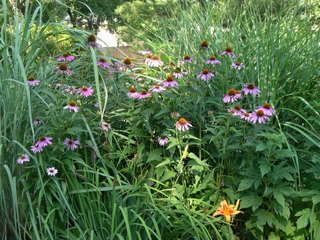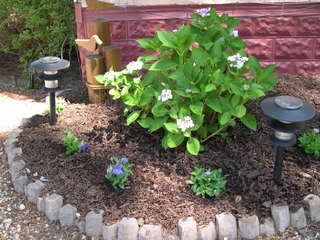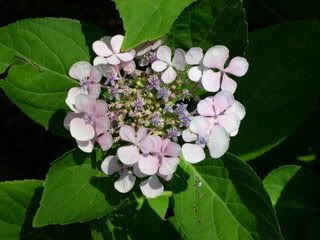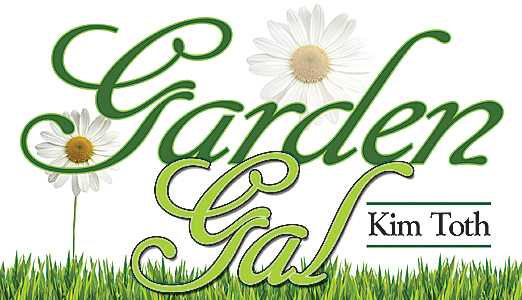Too Hot!
How are you doing out there? Managing to stay cool despite the HIGH temperatures? I know I am -- by staying indoors, TGFAC -- Thank God for Air Conditioning!!

Needless to say, this past weekend was a total bust for gardening. While I did manage to get outside twice to water, early in the morning before the humidity set in, I did not get anything else done. You know it's bad when you're standing still holding a hose and you can feel sweat running down your back and it's not even 10 a.m. yet!
So, my new pond plants still need to be rinsed of all dirt and repotted with gravel before being placed in their new water home. I did manage to get some of those new Lowe's purchases planted last week before the supreme heat wave, but a few others still remain on the table.
I got up early Saturday with the best intentions, but by 9:15 a.m. decided it would be much better for me to spend 2 1/2 hours at the local theater watching "The Dark Knight." And it was a good choice! By the time I got home around 1 p.m., the thermometer said 96 degrees and that was in the shade. So we sat in the air-conditioned sunroom and enjoyed the pond and the beautiful flowers in 72-degree comfort.
And the same was repeated on Sunday, only the movie was "Mamma Mia." Not such a good choice.
Had the climate been more formidable, I would've told you all about cutting back spent plants and transplanting older hostas to make room for the new ones I bought. Oh well, today begins another week ...

For now, how about a little on Lace Cap Hydrangeas? We were given a lace cap hydrangea last year by a neighbor at our shore home. Since I have eight at home, we decided to plant it there.
Unlike the typical hydrangea that has the common name of "snowball bush," lace cap hydrangeas have a distinctly different bloom. The "lace cap" refers to a flower that has very small bud-like blooms, generally in the center, in combination with larger showy florets on the outside, pictured here.

This shrub can grow three to six feet in height. It is a rounded shrub with many unbranched stems coming from the ground. It is cold hardy to Zone 6, but generally needs protection (i.e. mulch) in our area if you want it to bloom and grow to its full potential. This Hydrangea blooms in late June, July or August, depending upon the cultivar. The relatively flat-topped flowers range in color from white, to pink, to blue.
Most Hydrangeas are natural woodland plants and like some shade. Morning or late afternoon sun is OK, but the flowers can burn if exposed to mid-day sun. If a Hydrangea has been planted in a poor location is usually easy to move; it has a relatively small compact root ball. Hydrangeas will grow in almost any soil, but will do better if the soil retains moisture. They should be watered frequently enough that the soil does not completely dry out. Mine drooped each afternoon during this heat wave, and needed to be watered every evening.
This week, a vegetable garden update (remember those Earth Boxes?), balloon flowers, phlox, coneflowers (pictured at the top) and I hope to get to those Salvias!

Needless to say, this past weekend was a total bust for gardening. While I did manage to get outside twice to water, early in the morning before the humidity set in, I did not get anything else done. You know it's bad when you're standing still holding a hose and you can feel sweat running down your back and it's not even 10 a.m. yet!
So, my new pond plants still need to be rinsed of all dirt and repotted with gravel before being placed in their new water home. I did manage to get some of those new Lowe's purchases planted last week before the supreme heat wave, but a few others still remain on the table.
I got up early Saturday with the best intentions, but by 9:15 a.m. decided it would be much better for me to spend 2 1/2 hours at the local theater watching "The Dark Knight." And it was a good choice! By the time I got home around 1 p.m., the thermometer said 96 degrees and that was in the shade. So we sat in the air-conditioned sunroom and enjoyed the pond and the beautiful flowers in 72-degree comfort.
And the same was repeated on Sunday, only the movie was "Mamma Mia." Not such a good choice.
Had the climate been more formidable, I would've told you all about cutting back spent plants and transplanting older hostas to make room for the new ones I bought. Oh well, today begins another week ...

For now, how about a little on Lace Cap Hydrangeas? We were given a lace cap hydrangea last year by a neighbor at our shore home. Since I have eight at home, we decided to plant it there.
Unlike the typical hydrangea that has the common name of "snowball bush," lace cap hydrangeas have a distinctly different bloom. The "lace cap" refers to a flower that has very small bud-like blooms, generally in the center, in combination with larger showy florets on the outside, pictured here.

This shrub can grow three to six feet in height. It is a rounded shrub with many unbranched stems coming from the ground. It is cold hardy to Zone 6, but generally needs protection (i.e. mulch) in our area if you want it to bloom and grow to its full potential. This Hydrangea blooms in late June, July or August, depending upon the cultivar. The relatively flat-topped flowers range in color from white, to pink, to blue.
Most Hydrangeas are natural woodland plants and like some shade. Morning or late afternoon sun is OK, but the flowers can burn if exposed to mid-day sun. If a Hydrangea has been planted in a poor location is usually easy to move; it has a relatively small compact root ball. Hydrangeas will grow in almost any soil, but will do better if the soil retains moisture. They should be watered frequently enough that the soil does not completely dry out. Mine drooped each afternoon during this heat wave, and needed to be watered every evening.
This week, a vegetable garden update (remember those Earth Boxes?), balloon flowers, phlox, coneflowers (pictured at the top) and I hope to get to those Salvias!
Labels: heat wave, hydrangeas, lace cap hydrangeas
 RSS
RSS


